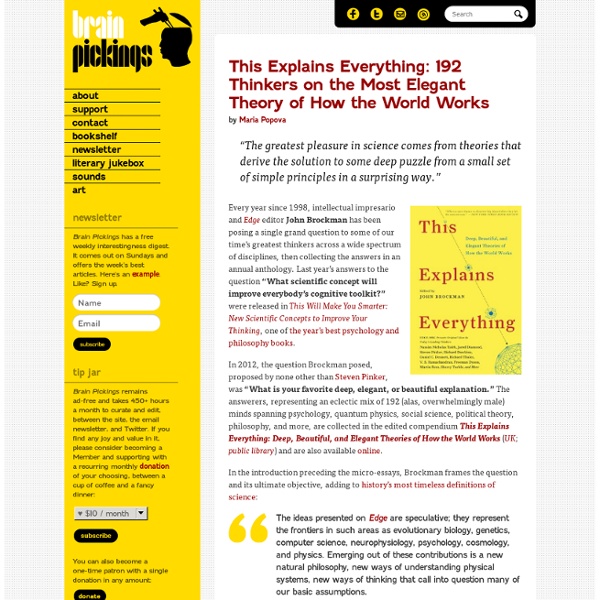



How to Be an Educated Consumer of Infographics: David Byrne on the Art-Science of Visual Storytelling As an appreciator of the art of visual storytelling by way of good information graphics — an art especially endangered in this golden age of bad infographics served as linkbait — I was thrilled and honored to be on the advisory “Brain Trust” for a project by Pulitzer-Prize-winning journalist, New Yorker writer, and Scientific American neuroscience blog editor Gareth Cook, who has set out to highlight the very best infographics produced each year, online and off. (Disclaimer for the naturally cynical: No money changed hands.) The Best American Infographics 2013 (public library) is now out, featuring the finest examples from the past year — spanning everything from happiness to sports to space to gender politics, and including a contribution by friend-of-Brain Pickings Wendy MacNaughton — with an introduction by none other than David Byrne. Accompanying each image is an artist statement that explores the data, the choice of visual representation, and why it works.
This Is What It Looks Like When You Realize How Toxic Your Job Is and You Do Something About It | Adrian Hoppel Websites Deciding to Offer Web Design in a Gift Economy Changed My Life. Here’s How. Last weekend, someone who is very important to me wrote something kind about me on Facebook, and since then many people have tried to get in touch with me. Like, a lot of people. From everywhere. The person was author and speaker Charles Eisenstein, and the kind words he wrote about me had to do with the website I designed for him. Here is what Charles wrote: The fact that people have reached out to me from around the world, seeking help with their website projects, simply because of these words, is a great example of not only the power of social media, but the magic of working in a Gift Economy. Let Me Explain. I’ve built websites for people for about 13 years now, the first 11 of which were done in the typical “here is my quote, I need this amount in deposit, and at the end, here is my bill” type of model. I don’t know…what did YOU expect? I always expected something different. So, How Do You Do It? I Was Very Wrong.
A Brief History of Anarchism The struggle for the common good has a long past. This broad tendency in human development seeks to identify structures of hierarchy, authority and domination that constrain human development, and then subject them to a very reasonable challenge: Justify yourself. Humans are social beings, and the kind of creature that a person becomes depends crucially on the social, cultural and institutional circumstances of his life. We are therefore led to inquire into the social arrangements that are conducive to people's rights and welfare, and to fulfilling their just aspirations—in brief, the common good. For perspective I'd like to invoke what seem to me virtual truisms. They relate to an interesting category of ethical principles: those that are not only universal, in that they are virtually always professed, but also doubly universal, in that at the same time they are almost universally rejected in practice. A good place to start is with John Stuart Mill's classic On Liberty.